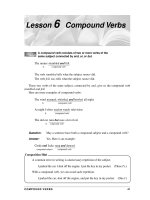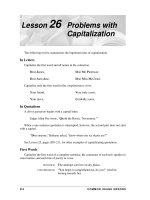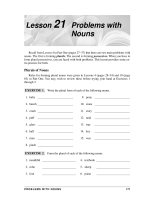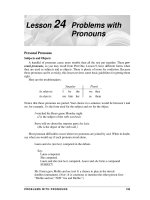Grammar And Usage For Better Writing - Problems with Sentence Structure
Bạn đang xem bản rút gọn của tài liệu. Xem và tải ngay bản đầy đủ của tài liệu tại đây (47.86 KB, 21 trang )
150 COMMON USAGE ERRORS
Lesson
20
Problems with
Sentence
Structure
There are three basic kinds of sentences: simple, compound, and complex. We already
encountered these sentence types in Parts One and Two. Here, we learn about the parts of
the sentences and how they work together. Along the way, you will have the opportunity to
broaden your understanding with a little practice.
Simple Sentences
In Part One (pages 3–10) you learned that a sentence must have a subject and a verb,
often called a predicate. In the following sentences, the subject has one line under it; the
verb (predicate) has two.
Maria yelled.
A section of the bridge fell during the recent storm.
These are simple sentences. Each one contains a subject and a verb. Either the subject or
the verb, or both, may be compound. Something that is compound has two or more parts.
The following sentences have compound parts:
COMPOUND SUBJECT
: Cindy and Jeffrey smiled.
COMPOUND VERB
: Cindy smiled and laughed.
COMPOUND SUBJECT
AND VERB
: Cindy and Jeffrey smiled and laughed.
EXERCISE 1.
Each numbered line consists of two sentences. Combine each pair
into one simple sentence with compound parts. The finished sentence may have either a
compound subject or a compound verb. (Be sure to make all necessary changes.)
1. Mario plays tennis. Carly also plays tennis.
2. The plane taxied on the runway. It finally stopped.
3. We visited Washington, D.C. We toured the city.
4. Jacy bought some new CDs. She stacked them on the shelf in her room.
5. The Tigers play their games in the city’s stadium. The Lions, too, play their games in
the city’s stadium.
Compound Sentences
As we learned in Part One (pages 105–107), two or more simple sentences can be
combined to form a compound sentence.
SIMPLE SENTENCE
: Dogs show affection for their owners.
SIMPLE SENTENCE
: Cats are more aloof.
COMPOUND SENTENCE
: Dogs show affection for their owners, but cats
are more aloof.
The parts of a compound sentence are often joined together by and, but, or, or nor.
These “joining words” are called coordinating conjunctions.
When two sentences are joined to make a compound sentence, the two main parts are
called clauses. Because these two parts can stand by themselves as complete sentences,
they are called independent clauses.
COMPOUND SENTENCE
: The bell rang, AND students quickly filled
the halls.
COMPOUND SENTENCE
: Are you coming to the game, OR have you
made other plans?
COMPOUND SENTENCE
: Rob doesn’t like lima beans, NOR does he
care for spinach. (To identify subject and
verb, mentally arrange the sentence in sub-
ject-verb order: “he does care for spinach.”)
EXERCISE 2.
Combine each pair of sentences to form a good compound sentence.
Use and, but, or, or nor. Make slight changes in wording, if necessary.
1. You may think of Dobermans as vicious dogs. Many of them are gentle.
PROBLEMS WITH SENTENCE STRUCTURE 151
2. Tropical fish require great care. They may become sick and die.
3. Lightning struck the tree. The bark peeled off in layers.
4. Jim did not mow the lawn. He did not trim the hedges.
5. The rain poured down. The sun was shining.
Complex Sentences
We worked with complex sentences in Part Two (page 140) and saw how they can add
interest and variety to writing. Now we look more closely at what makes a complex sen-
tence. Like a compound sentence, a complex sentence has two or more clauses, but at least
one of the clauses cannot stand by itself as a sentence. Note the following example:
COMPLEX SENTENCE
: If Paula calls, give her my message.
FIRST CLAUSE
: If Paula calls, (subordinate clause)
SECOND CLAUSE
: give her my message. (independent clause)
The first clause cannot function alone as a sentence. Although it has both a subject and
a verb, it needs something to complete its thought. It is a subordinate clause. The second
clause can stand by itself. It is an independent clause with the understood subject you.
Subordinate Clauses
Subordinate clauses can be difficult. Sometimes we make the mistake of punctuating
them as if they were complete sentences. Then we end up with a sentence fragment, which
will be covered in the next section (pages 155–164).
Subordinate clauses begin with connectives, or “joining words,” called subordinating
conjunctions. Here’s a partial list:
after before than until
although how though when
as if till while
because since unless why
152 COMMON USAGE ERRORS
In the following sentences, the conjunctions are capitalized, the subordinate clauses
are circled, and the independent clauses are underlined.
COMPLEX SENTENCE
: Juan went home WHEN the game ended.
COMPLEX SENTENCE
: BEFORE the movie started, Kris bought
popcorn.
EXERCISE 3.
Circle the subordinate clause in each sentence. Draw a line under
each clause that could stand by itself as a sentence.
1. After the TV show ended, I began my homework.
2. Natasha won’t leave until Cindy arrives.
3. The rain will get heavier before it stops.
4. Although Jordan loves ice cream, he is going on a diet.
5. When the film is ready, pick it up from PhotoFlash.
More on Subordinate Clauses
Another type of subordinate clause begins with the pronoun who, which, or that. In
the following sentences, the subordinate clauses are circled. You can see that they cannot
stand by themselves as sentences.
COMPLEX SENTENCE
: Ellen is the girl WHO won the golf tournament.
COMPLEX SENTENCE
: The creamy filling, WHICH is the best part of
the cookie, was eaten first.
COMPLEX SENTENCE
: The part of the movie THAT I liked best was
the ending.
EXERCISE 4.
Circle the subordinate clause in each sentence. Be careful not to circle
part of the independent clause.
1. Caroline, who has not missed a school day in two years, is a friend of Sasha’s.
2. The Statue of Liberty is the sight that has greeted millions of new immigrants.
3. Basketball, which was invented by an American, is now played around the world.
4. The violinist Itzhak Perlman is a man who has overcome serious physical disabilities.
5. One plant that everyone should avoid is poison ivy.
PROBLEMS WITH SENTENCE STRUCTURE 153
EXERCISE 5.
Identify each sentence by writing Simple, Compound, or Complex
on the line.
1. The movie was good, but I enjoyed the book more.
2. Her flight was canceled, and the trip was postponed.
3. Katherine Lee, who was chosen to represent our
school, could not attend the meeting.
4. The teachers and the students stood together.
5. The car skidded and almost struck a utility pole.
6. Lisa replaced the glass that she had broken.
7. Are you buying new clothes?
8. He used his computer to make party invitations.
9. When buses are delayed, students are usually late
for school.
10. Disneyland and Hollywood are popular places to
visit in California.
EXERCISE 6.
Combine each pair of sentences to make one complex sentence. If
you need help, look again at the list of subordinating conjunctions on page 152.
1. The sunrise was beautiful. A storm rolled in by eleven.
2. Nick made it to class on time. Miranda was late.
3. Tom plays professional football. His brother is more talented in baseball.
4. My brothers Sean and Ian are going skiing. The snow is deep enough.
154 COMMON USAGE ERRORS
5. I left a note for the teacher. She never got my note.
6. I will have to wait a long time to buy my ticket. The line of people stretches for
blocks.
7. Jeff is on the track team. He finished next to last in the first round of pole vault.
8. Don’t forget to volunteer your time. The animal shelter needs a lot of help this time
of year.
9. The lawyer rose slowly. The jury looked at him with expectation.
10. Carlo was studying in his room. Noisy construction was going on outside.
Sentence Fragments
One of the key skills you will need is the ability to write complete sentences. The sen-
tence fragment is a pitfall to avoid.
Question:
What is a sentence fragment?
Answer:
When a group of words does not express a complete thought, it is a
sentence fragment.
Here are some examples of them. Although they begin with a capital letter and have end
punctuation, they are not complete sentences. Study ways they can be made into complete
sentences.
NO VERB
: Raquel, along with a friend of hers from
Dallas.
COMPLETE SENTENCE
: Raquel arrived, along with a friend of hers
from Dallas.
PROBLEMS WITH SENTENCE STRUCTURE 155
NO VERB
: A small puppy running across the lawn.
(The word running by itself is not a verb. It
needs a helping verb like is or was. See
Verbals as Fragments, page 161.)
COMPLETE SENTENCE
: A small puppy was running across the lawn.
NO SUBJECT
: Took the train from Boston to New Haven.
COMPLETE SENTENCE
: He took the train from Boston to New Haven.
NO VERB
,
NO SUBJECT
: From my uncle in Dallas.
COMPLETE SENTENCE
: I got a gift from my uncle in Dallas.
A common error is the use of a prepositional phrase as a complete sentence. A
preposition relates the noun or pronoun following it to some other part of the sentence
(see Lesson 14 in Part One, page 94). A phrase is a group of connected words that does
not contain a subject or a predicate.
PREPOSITIONAL PHRASE
: Near the monitor on the desk.
COMPLETE SENTENCE
: An owner’s manual lay near the monitor on
the desk.
EXERCISE 7.
Transform each sentence fragment into a complete sentence. Add
words as needed.
1. At the bus stop on the corner near the Wal-Mart store.
2. Gabrielle, unhappy with the test results.
3. Lost my new watch somewhere in the locker room.
4. Enjoying the ski slopes of the Pocono Mountains.
5. The new Spike Lee film showing at a local theater.
156 COMMON USAGE ERRORS
6. An electric guitar in one corner and an amplifier in the other.
7. Carried the soccer equipment from the car to the garage.
8. The football team lining up for the kickoff.
9. Reaching first-period class as the bell rang.
10. The lead singer with the band behind him on the stage.
EXERCISE 8.
Change each sentence fragment into a complete sentence. Add what-
ever words are necessary.
1. Because I had never tasted tofu before.
2. A notebook lying on a bench in the locker room.
3. A deep freeze, a cause of many accidents on the slick roads.
4. Solved the third geometry problem after half an hour of hard work.
PROBLEMS WITH SENTENCE STRUCTURE 157









